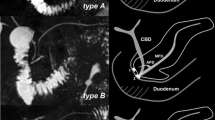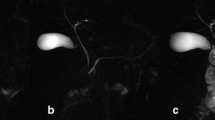Abstract
Background
Secretin—a hormone that stimulates pancreatic exocrine secretion—is described to improve visualization of the pancreatic duct by magnetic resonance cholangiopancreatography (MRCP). In our pediatric practice, however, we have not observed substantial benefit with the use of secretin.
Objective
To determine whether secretin dilates and improves visualization of the pancreatic duct in pediatric MRCP.
Materials and methods
Retrospective evaluation of secretin-enhanced MRCPs performed over a 15-month period. One reviewer measured the pancreatic duct pre- and post-secretin and two reviewers, blinded to the administration of secretin, assessed image quality and subjective duct visibility. Similar assessments of the biliary tree served as internal controls.
Results
We reviewed 20 MRCPs in 17 children. Following secretin administration, there was a small (0.3 mm) but statistically significant increase in pancreatic duct diameter (P = 0.002) and small (<0.2 mm) but significant increase in intrahepatic bile duct diameter (P = 0.0104). On subjective review, there was no significant difference in image quality or duct visibility based on the administration of secretin.
Conclusion
Secretin induces dilatation of the pancreatic duct but the value of that effect in pediatric MRCP is suspect given the small change in duct diameter and the lack of improvement in image quality and duct visibility.


Similar content being viewed by others
References
Chavhan GB, Babyn PS, Manson D et al (2008) Pediatric MR cholangiopancreatography: principles, technique, and clinical applications. Radiographics 28:1951–1962
Arcement CM, Meza MP, Arumanla S et al (2001) MRCP in the evaluation of pancreaticobiliary disease in children. Pediatr Radiol 31:92–97
Hosoki T, Hasuike Y, Takeda Y et al (2004) Visualization of pancreaticobiliary reflux in anomalous pancreaticobiliary junction by secretin-stimulated dynamic magnetic resonance cholangiopancreatography. Acta Radiol 45:375–382
Manfredi R, Costamagna G, Brizi MG et al (2000) Severe chronic pancreatitis versus suspected pancreatic disease: dynamic MR cholangiopancreatography after secretin stimulation. Radiology 214:849–855
Manfredi R, Costamagna G, Brizi MG et al (2000) Pancreas divisum and “santorinicele”: diagnosis with dynamic MR cholangiopancreatography with secretin stimulation. Radiology 217:403–408
Manfredi R, Lucidi V, Gui B et al (2002) Idiopathic chronic pancreatitis in children: MR cholangiopancreatography after secretin administration. Radiology 224:675–682
Matos C, Metens T, Deviere J et al (1997) Pancreatic duct: morphologic and functional evaluation with dynamic MR pancreatography after secretin stimulation. Radiology 203:435–441
Matos C, Metens T, Deviere J et al (2001) Pancreas divisum: evaluation with secretin-enhanced magnetic resonance cholangiopancreatography. Gastrointest Endosc 53:728–733
Nicaise N, Pellet O, Metens T et al (1998) Magnetic resonance cholangiopancreatography: interest of IV secretin administration in the evaluation of pancreatic ducts. Eur Radiol 8:16–22
Delaney L, Applegate KE, Karmazyn B et al (2008) MR cholangiopancreatography in children: feasibility, safety, and initial experience. Pediatr Radiol 38:64–75
Sanyal R, Stevens T, Novak E et al (2012) Secretin-enhanced MRCP: review of technique and application with proposal for quantification of exocrine function. AJR 198:124–132
Cappeliez O, Delhaye M, Deviere J et al (2000) Chronic pancreatitis: evaluation of pancreatic exocrine function with MR pancreatography after secretin stimulation. Radiology 215:358–364
Akisik MF, Sandrasegaran K, Aisen AA et al (2006) Dynamic secretin-enhanced MR cholangiopancreatography. Radiographics 26:665–677
Geenen JE, Hogan WJ, Dodds WJ et al (1980) Intraluminal pressure recording from the human sphincter of Oddi. Gastroenterology 78:317–324
Laugier R (1994) Dynamic endoscopic manometry of the response to secretin in patients with chronic pancreatitis. Endoscopy 26:222–227
Hellerhoff KJ, Helmberger H 3rd, Rosch T et al (2002) Dynamic MR pancreatography after secretin administration: image quality and diagnostic accuracy. AJR 179:121–129
Sai JK, Ariyama J, Suyama M et al (2002) Occult regurgitation of pancreatic juice into the biliary tract: diagnosis with secretin injection magnetic resonance cholangiopancreatography. Gastrointest Endosc 56:929–932
Song HK, Kim MH, Lee SK et al (2003) Progressive bile duct and gallbladder dilation on MRCP after secretin stimulation: physiologic or pathologic finding? Gastrointest Endosc 58:165, author reply 165–166
Alvaro D, Gigliozzi A, Fraioli F et al (1997) Hormonal regulation of bicarbonate secretion in the biliary epithelium. Yale J Biol Med 70:417–426
Acknowledgments
This publication was supported by an Institutional Clinical and Translational Science Award, NIH/NCATS grant number 8UL1TR000077-04. Its contents are solely the responsibility of the authors and do not necessarily represent the official views of the NIH.
Conflicts of interest
None
Author information
Authors and Affiliations
Corresponding author
Rights and permissions
About this article
Cite this article
Trout, A.T., Podberesky, D.J., Serai, S.D. et al. Does secretin add value in pediatric magnetic resonance cholangiopancreatography?. Pediatr Radiol 43, 479–486 (2013). https://doi.org/10.1007/s00247-012-2561-5
Received:
Revised:
Accepted:
Published:
Issue Date:
DOI: https://doi.org/10.1007/s00247-012-2561-5




